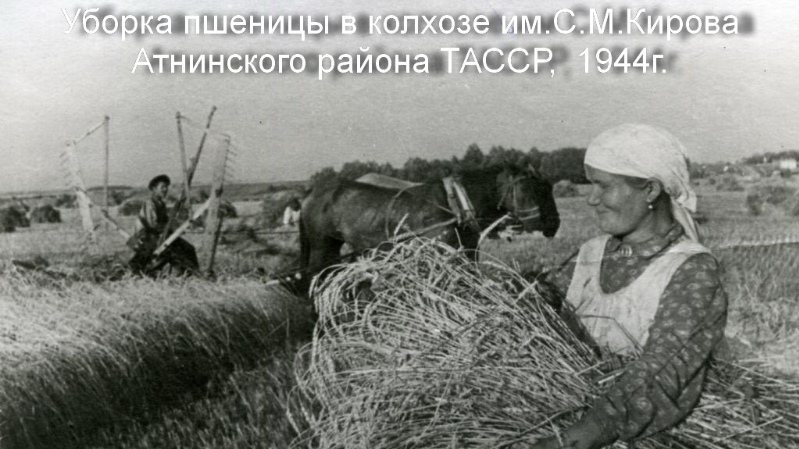Agricultural production of the TASSR during the Great Patriotic War: the contribution of rural workers to the Victory

The Ministry of Agriculture and Food of the Republic of Tatarstan with great respect for the veterans of the Great Patriotic War of 1941-1945. and those who worked in the rear in those years, providing the country's food supply. Today we are opening a series of publications devoted to agriculture of the TASSR during the Great Patriotic War, in which we will tell how Tatarstanians raised bread, women became the leading force in the agricultural sector, about workdays and children working in the fields.
With the beginning of the war, the importance of Tatarstan, as well as other rear regions of the country, in the food supply of the army and the population increased significantly. This happened for objective reasons: the USSR had already temporarily lost the most important agricultural areas in the west of the country in the first months of the war: territories that accounted for 47% of all sown areas and about 50% of livestock were taken by the enemy. However, the expansion of agrarian production in the TASSR was extremely difficult. The supply of tractors and agricultural machinery had practically ceased. Most of the tractors and automobiles in the farms (up to 80%) that were owned by the MTS and collective farms were transferred for the needs of the army. There was an acute problem of fuel. Attempts to replace farm machinery by horses also failed. Already in the first year of the war, 10% of total livestock of the republic’s horses were mobilized to the front, and 10-20% of the remaining were constantly diverted by the state to perform horse-drawn duties.
In connection with the sharp reduction of technology, live tax, energy, manual labor has acquired particular importance. But the solution of the personnel issue in the agrarian sector was accompanied by even greater difficulties. According to experts, the number of rural working-age population in our region during the war years has decreased by more than one-third. In addition, the general mobilization was primarily of men - the most able-bodied part of the productive forces of agriculture. It should be added that even the available rural population could not be fully used in the agrarian sphere, since It was the villagers who served as the main source of replenishment of labor for republican enterprises and were subject to mobilization, according to the regulations.
Women became the main driving force in the agrarian sector during the war years. In the collective farms of Tatarstan, they worked out up to 70–75% of the total number of workdays, they also made up 75% of the permanent working state farms.
Child labor was especially widely used for weeding, haying, threshing, harvesting, etc. The school year in rural schools began later.
On April 13, 1942, the Central Committee of the CPSU and the Council of People's Commissars of the USSR adopted an emergency resolution that provided an increase in the mandatory minimum of workdays for villagers: for the adult population it was set at 100-150 workdays per year, for adolescents 12–16 years old - not less. Failing to comply with this minimum without good reason, the collective farmers could be brought to justice. In addition, they were considered retired from the collective farm and deprived of the backyard plot. Working out working days was even more important because the quantity of food depended on the amount of food issued to the peasants during the war period (as opposed to the townspeople, the collective farmers were not provided with cards). But the collective farms issued food to their employees only after the fulfillment of mandatory state deliveries of agricultural products.
Fulfilling the tasks of the party and the government, the villagers worked with full dedication. Eyewitnesses of those years say that after hard grueling work they did not even have the strength to reach home. And yet, despite the double-triple efforts of the collective farmers, the situation in the agriculture of Tatarstan remained difficult. An objective picture of the state of agrarian production was reflected in his writings by Z.I. Gilmanov. According to the data analyzed by him, during the war period, the sown area in the republic decreased from 3199 thousand to 2130 thousand hectares, i.e. by almost one third. The area under wheat, the main grain crop, decreased by 2 times, and by 2.5 times under fodder crops . A slight increase in acreage occurred only under potatoes and melon crops. In addition, a new agricultural crop appeared in the republic - sugar beet. The volume of tractor work was significantly reduced, which in turn affected the level and degree of mechanization of the main agricultural works. Also in the war years, the level of agricultural engineering decreased: the supply of mineral fertilizers was almost stopped. As a result, the yield per hectare decreased by more than half, and the annual grain harvest for 1942-1945 decreased by more than 2.5 times.
At the same time, during the four years of the war, the agrarian sector of the republic produced and delivered to the state 131 million pounds of bread, 39 million pounds of potatoes and vegetables, 56 million pounds of meat, 200 million liters of milk, tens of thousands of pounds of butter, fat, honey and other products. It was a significant contribution to the victory. Denying themselves the most necessary, rural workers gave the state a large part of products.